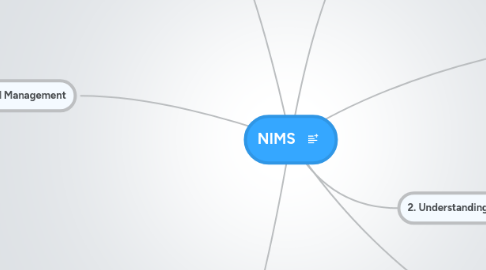NIMS
von T Grady

1. 5. Resources
1.1. Objectives
1.2. Planning
1.3. Resource Identification and Ordering
1.4. Effective Resource Management
1.5. Resource Cycle and Flow of Requests
1.6. Avoid bypassing systems
1.7. Identifying and Typing Resources
1.8. Credentialing
2. 6. Command and Management
2.1. Incident command system
2.1.1. Elements
2.1.1.1. ICS
2.1.1.1.1. ICS Overview
2.1.1.1.2. Features of ICS
2.1.2. Roles
2.1.3. Definitions
2.2. Multiagency Coordination
2.2.1. EOC
2.2.2. On-Scene/Off-Scene
2.3. Public Information
2.3.1. Summary
2.3.2. PIO
2.3.3. JIC
2.3.4. One Voice
2.3.5. JIS
3. 7. Course Summary
3.1. Role of NIC
4. 1. Overview/Objectives
4.1. Paricipants
4.2. Berlin: Partners
4.3. NIMS
4.4. Reality
4.5. Expecations
4.6. Logistics
4.7. NIMS Document Orientation
5. 2. Understanding NIMS
5.1. Objectives
5.2. Overview
5.3. NIMS is
5.4. HPSD 5
5.5. NIMS Mandate
5.6. Collaborative Incident Management
5.7. Best Practices
5.8. NIMS is Dynamic
5.9. Flexibility
5.10. Standardization
5.11. NIMS components
6. 3. Preparedness
6.1. Objectives
6.2. HPSD
6.3. NIMS/NRF
6.4. A Continuous Cycle
6.5. A unified approach
6.6. Levels of Capability
6.7. Coordination of Preparedness
6.8. Preparedness efforts
6.9. Continuity and capability
6.10. Discussion Questions
6.11. Mutual Aid and Assistance Agreements
6.12. Procedural Documents
6.13. Protocols
6.14. Training
6.15. Qualifications and Certifications
6.16. Mitigation and Proeparedness
6.17. Preparedness and Self-Assessment
7. 4. Communication
7.1. Objectives
7.2. Effective Communication
7.3. Common Operating Picture
7.4. Interoperability
7.5. Reliability, Portability, Scalability
7.6. Resiliency and Redundancy
7.7. Communication Types
7.8. Policy and Planning
7.9. Equipment Standards and Training
7.10. Incident Information
7.11. Communication and Data Standards
7.12. Plain Language and Common terminology


